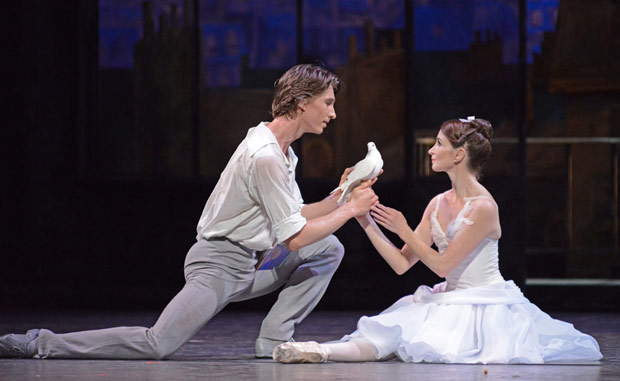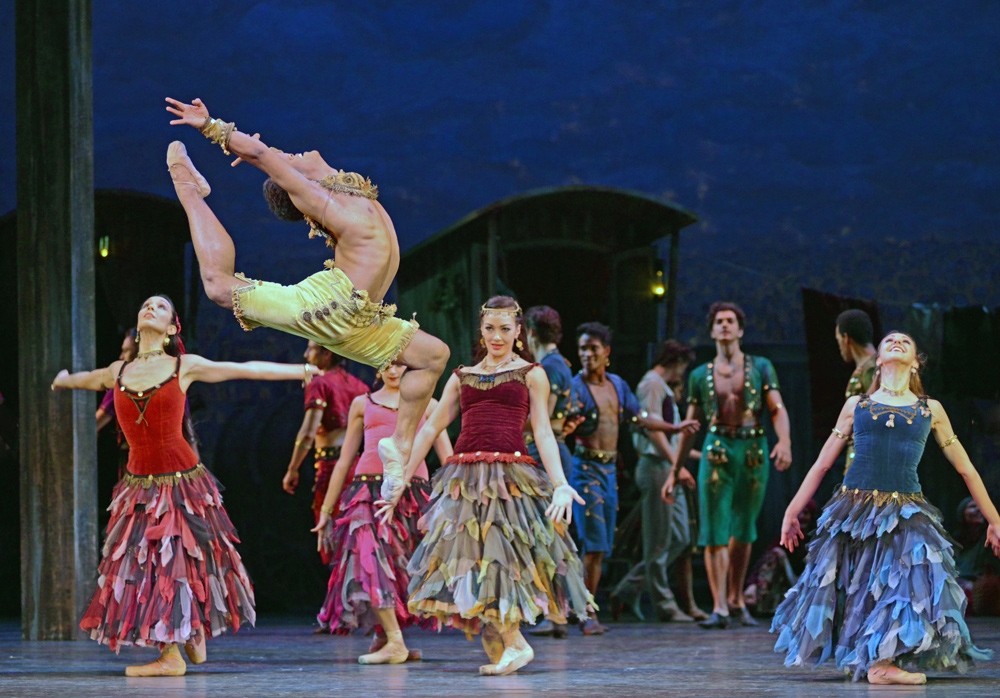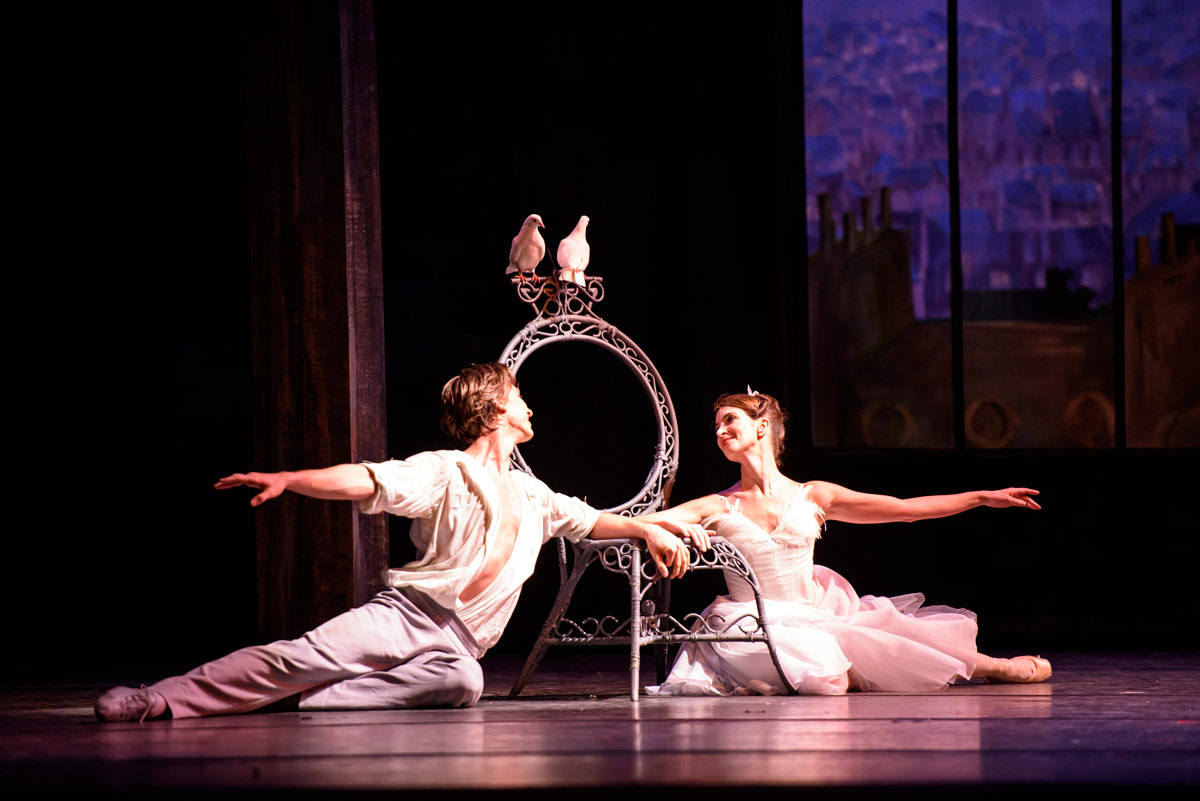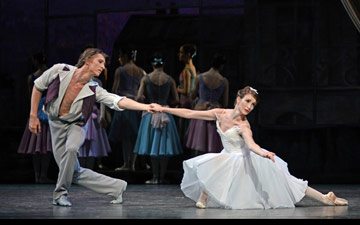
© Dave Morgan, courtesy the Royal Opera House. (Click image for larger version)
Royal Ballet
Monotones I & II, The Two Pigeons
London, Royal Opera House
18 November 2015
Gallery of pictures by Dave Morgan
www.roh.org.uk
Frederick Ashton’s Monotones proved an apt choice of dedication by Kevin O’Hare, the Royal Ballet’s artistic director, to all those affected by the recent Paris atrocities. The adagio trios to Erik Satie’s limpid music have the celestial serenity of a timeless, untroubled universe.
When Ashton created the companion pieces in 1965 and 1966, man had yet to set foot on another planet. The six dancers occupy space like idealised cosmonauts, weightless and streamlined instead of bulky and cumbersome, moving to the music of the spheres.

© Dave Morgan, courtesy the Royal Opera House. (Click image for larger version)
The green trio, Monotones I, is gender neutral. The three figures execute the same academic steps in unison, their limbs at the same angles. The only difference is that the man (Tristan Dyer in the role created by Brian Shaw) is the principal supporter of the two women on pointe (Emma Maguire and Yasmine Naghdi). The choreography is based on pacing and lunging to the pulse of Satie’s Trois Gnossiennes, torsos curving as shoulders twist in épaulement. Exacting and exposed, Montonones I was immaculately danced on Tuesday.

© Bill Cooper, ROH, 2015. (Click image for larger version)
The white trio, Monotones II, to Trois Gymnopédies was in fact created first, for a gala. Ashton experimented with using three bodies as ribbons, threading them round each other, the woman suspended between the two men. It was the first time he exploited the hyper-extension of a woman (Vivyan Lorrayne) and the elegant matching arabesque lines of two supple men (Antony Dowell and Robert Mead). Audiences are now accustomed to the manic acrobatic contortions of modern choreography, so it is rewarding to see the rigour with which the three performers (Marianela Nunez, Valeri Hristov and Edward Watson) control their elasticity. More than Monotones I, the white trio is an essay in the gallantry of male-female partnering, hands courteously extended instead of grabbed.

© Dave Morgan, courtesy the Royal Opera House. (Click image for larger version)
When The Two Pigeons (or Les deux Pigeons, as Ashton’s ballet was known in 1961) was first performed at a gala on the Royal Opera House stage, the critic Richard Buckle damned it as quaintly old-fashioned. He had changed his mind by 1966: ‘We were put off by the sweetness of the tunes and story, by the nostalgia for the nineteenth century, by the insipidity of the sets and by those glittering brown gypsies with their strong white teeth. Now we accept the work as part of the repertory, part of our French heritance like Giselle and La Fille mal gardée and Coppélia.’
But The Two Pigeons had been dropped from the Royal Ballet rep. for the past 30 years until this revival, although the touring company, now Birmingham Royal Ballet, has continued to perform it (and the RB School used to do it for graduation performances). The problem is Ashton’s gypsies, who are even more unconvincing on an English ballet stage than those in Don Quixote.

© Dave Morgan, courtesy the Royal Opera House. (Click image for larger version)
Ashton inherited them from the original scenario by Louis Mérante, choreographer of Les deux Pigeons in 1886. A band of gypsies provide the exotic allure that attracts the heroine’s boyfriend away from her. The story is based on a fable by La Fontaine about two pigeons (or doves), one of whom sets out in search of adventure, has a hard time and returns home, chastened.
We need to accept that Ashton’s ballet is a fable of love repentant, replete with avian imagery. In his version, the Young Man is an artist, painting the Young Girl in a Parisian attic. Two white birds fly past, inspiring the couple to imitate their preening, billing and cooing, and their quarrels. The heroine’s eight girlfriends echo the birdlike movements. Though the choreography for the lovers (Lauren Cuthbertson and Vadim Muntagirov) is funny and ingenious, that for the girlfriends is nowhere near as spirited as for the female corps in La Fille mal gardée.

© Dave Morgan, courtesy the Royal Opera House. (Click image for larger version)
Then the gypsies just happen to drop up – or rather down, for they enter this rooftop attic down a flight of stairs. The penniless artist flings them a handful of coins to encourage them to perform a czardas or two. He is captivated by the Carmen-like Gypsy Girl (Laura Morera) and follows her to the gypsy encampment at the end of Act I.
Murntagirov is charming and true as a restless young artist who doesn’t want to have his wings clipped by marriage just yet. He falls for a temptress who knows what she wants, unlike his wheedling, coquettish girlfriend. Morera’s gypsy is indeed a sexy firecracker, lighting up the dingy attic. Cuthbertson, a bit of a hoyden, is far from a cutie-pie as the Young Girl. Though plausibly complacent at first, annoying her boyfriend by refusing to sit still and playing queen of the coop with her would-be bridesmaids, she makes a fool of herself with jealousy. Her hissy-fit duel with the Gypsy Girl seems spontaneously flustered, feet and arms flailing. But her vulnerability isn’t really touching until the end of the second act.

© Dave Morgan, courtesy the Royal Opera House. (Click image for larger version)
The gypsy camp is straight out of a nineteenth century operetta. Marcelino Sambé has a fine turn as a roguish pickpocket; Ryoichi Hirano smoulders aggressively as alpha male; Morera enjoys André Messager’s best tunes for her vivacious variations. But the ensemble numbers for the gypsy corps, however fleet footed, are preposterous. Once they are out of the way, the ballet becomes irresistible.
Muntagirov’s long lines are amplified by the ropes tied to his arms like wings by the gypsies who lassoed him. The dove that flies to his wrist is carried back to the attic as he returns, contrite, to the Young Man’s first love-in-an-attic. Their reconciliation has echoes of Swan Lake’s Act II pas de deux, as the Girl flutters and yields in his embrace. Both Cuthbertson and Muntagirov reveal how their characters have matured into true love before the second bird flies in to join the first atop their heart-shaped curtain-closer pose.

© Bill Cooper, ROH, 2015. (Click image for larger version)
It’s a joy to have the ballet back for the three leading roles – the Young Man, Girl and Gypsy Queen. Different casts will find their own interpretations in choreography that tests their speed, accuracy and musicality. (Lovingly conducted by Barry Wordsworth, Messager’s score, arranged by John Lanchbery, is tooth-achingly sweet.) The corps will have to put up with their busy, unrewarding minor roles: they’ve known worse in recent ballets. Christopher Carr, who took a well-earned curtain call on the revival’s first night, is to be thanked for his meticulous retrieval of this neglected part of our Anglo-French heritance.

















You must be logged in to post a comment.